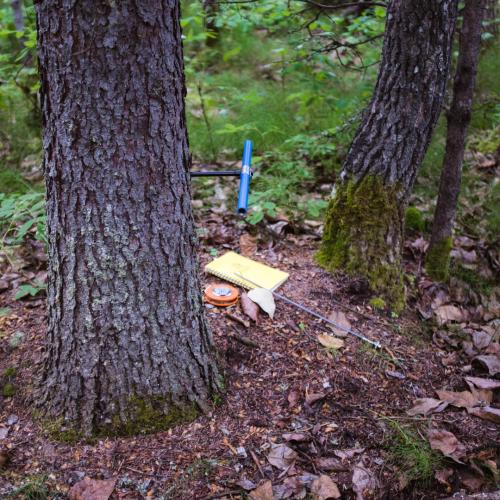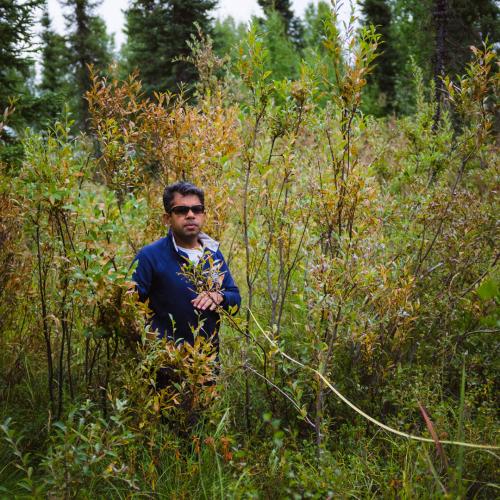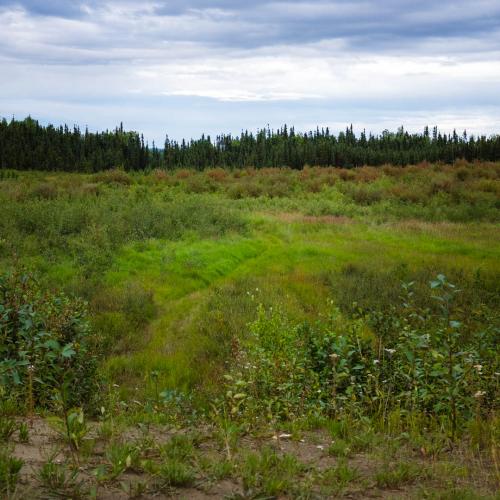...is this your first visit to my journal? Start on Day 1! Archive stored here: https://www.polartrec.com/expeditions/permafrost-and-community
So I keep telling you that I’m going to be unreachable and away from internet, and I keep lying to you. The clouds were too low today, so we’re still stuck in Nikolai. I didn’t know this, mostly because I’d never thought about it, but small planes don’t use instruments to navigate, so they have to be able to see the ground to find a place. We waited until around 4 pm and then just gave up… here we are for another day, and I'm getting out of the prediction business when it comes to when I'll have internet. Luckily our schedule is flexible, so we’re just breaking up our stay in Nikolai, and we’ll fit our time in Telida into the middle. I can tell that Teresa's getting anxious though, so here's hoping the weather lifts tomorrow.
To make the best of our time, we set off today to visit the permafrost monitoring sites again. Sasha and Santosh split up again to work on different tasks, both having to do with trees, and Sam, Teresa and I helped out where we could.
 Or I shirked and took photographs. I got a little manic with it because the light was so much better today, with it being overcast.
Or I shirked and took photographs. I got a little manic with it because the light was so much better today, with it being overcast.
Sasha was looking at tree growth by measuring diameter and collecting cores from nine trees around the permafrost monitoring stations we visited. You drill a hollow tube into the trunk, then poke a little trough in through the middle of it and pull out the core. You can count the tree rings to tell how old it is and measure their width to tell how much the tree grew in each particular year. I asked how he chose the trees, and he said it was pretty much just whichever random one caught his eye.
 Supplies for taking tree cores.
Supplies for taking tree cores.
 Sasha came up with his own tricky system for storing tree cores. Each one gets its own crease in the cardboard, and then he squishes it up and wraps the whole thing in duct tape.
Sasha came up with his own tricky system for storing tree cores. Each one gets its own crease in the cardboard, and then he squishes it up and wraps the whole thing in duct tape.
 Information about each tree goes in the crease next to its core.
Information about each tree goes in the crease next to its core.
Meanwhile, Santosh was measuring tree density in each area. What we did is by laying out three 10 meter transects pointing North-to-South, with the permafrost monitoring station in the middle (a transect is just an imaginary straight line you walk along). Once we had each transect set with a tape measure, Santosh would walk along it with a meter stick held away from his chest. Any tree the stick hit, we would count.
 Walking a transect.
Walking a transect.
 Planning the next transect.
Planning the next transect.
 You can see our system for recording data. Each of the three lines is a transect, with the number of trees along the transect recorded on both the right and left side.
You can see our system for recording data. Each of the three lines is a transect, with the number of trees along the transect recorded on both the right and left side.
 My contribution to science.
My contribution to science.
I asked Sasha to explain why we were out measuring trees, when the project is about permafrost, and he said that it is an addition to the project that they hadn’t originally planned on. When they proposed the project, they wanted to sample different ecotypes around each village. Once they got out there, though, they realized that what they had was the same ecotype, just at different stages of regeneration after a fire. How, they wondered, is this pattern of regrowth tied to permafrost?
Permafrost and trees both influence each other. I originally guessed that trees would do better without permafrost, but Sasha corrected me that they actually like it, because when permafrost thaws, water drains away and the soil gets quite dry. Trees, in turn, shade the ground, which can keep it cooler. So what Sasha and Santosh are essentially doing with these tree surveys is to look for correlations between the permafrost thaw they measure and factors like tree growth or tree density.
I asked if they were also thinking about subsistence foods like berries, and although it’s not part of their current research, Sasha is scheming for the future. He wants to know what happens to blueberries and cranberries with permafrost thaw. His guess was that soil moisture would have an effect, like with trees, but after talking with experts, they told him not so much. So what he did is go dig up a wild blueberry bush and plant it in his yard. He knows the soil there is basic, and blueberries don’t do well with that, so he added acidity, and they did better. Soil acidity changes with moisture, which changes with permafrost thaw, so voila, Sasha has a new question he’s curious about. Get this guy another grant ;)
 Berries are everywhere around Nikolai. Teresa went picking later.
Berries are everywhere around Nikolai. Teresa went picking later.
Halfway through the field work Santosh stepped on a hidden wasp nest. I was crouching down taking photos of him, but as soon as I saw what was happening I was OUTTA THERE. They seemed to gravitate to Sam, like all the bugs have today, and the poor thing got one bazillion stings. I told her I wouldn’t characterize her reaction as a “scream”… it was really more of a yelp. Personally I thought she carried herself with poise given that she was being swarmed by wasps.
 He looks serene here, but two seconds later he stepped on a wasp nest.
He looks serene here, but two seconds later he stepped on a wasp nest.
ANYWAY, Sam, Teresa, and Vicki left for about thirty minutes to take care of wasp stings, while the rest of us finished up fieldwork. Then we all went back indoors to hide from mosquitoes, eat lunch, and yawn. Sam and Teresa had an interesting conversation about grant writing, which I eavesdropped on. I write grants occasionally for OMSI, but the ones I work on are generally to the same federal funders, so I was curious to hear about their strategies with the variety of programs the apply to. This is actually how Sasha and Santosh linked up with Teresa: part of her job is to land creative salary opportunities for the tribe, and she and her colleague thought that partnering with permafrost scientists would be a good way to employ people in the villages while answering useful (and fundable) ecological questions. Vicki is employed through this grant, and we will be doing fieldwork with a number of others once we get to Telida. It seems like it’s been a positive experience for everyone, so while this grant is ending soon, I’m overhearing a lot of conversations about how to keep the partnership going.
I spent the rest of the day lazing about and chatting with people who stopped by to visit Teresa. A real honor was getting to hear an elder speak Athabaskan. Her generation was beaten for speaking their language when they were children in school, under a U.S. policy of forced assimilation, so theirs is the only one here that speaks it fluently.
Teresa later told me that a linguist identified 22 dialects when he visited the Upper Kuskokwim region. He worked to record one, and when Teresa asked why that one, he said he had to choose, and it was just the one he went with. It reminds me of Sasha talking about selecting trees: "random." One out of 22... nine out of a forest. Western science can be useful, but it’s limited; it can't replace the depth of traditional knowledge.
Tonight, Vicki took Sam and I on a tour of Nikolai. I’m feeling so grateful to be here. Here is Nikolai as seen from the back of an ATV:




 Talia has obviously spent the first two years of her life on an ATV. She's as comfortable on it as her mom.
Talia has obviously spent the first two years of her life on an ATV. She's as comfortable on it as her mom.
 Never enough baby pics.
Never enough baby pics.
 By the river.
By the river.
 This is a fish wheel, which spins and scoops fish up from the river. Vicki told us they mostly use it to catch food for the dogs.
This is a fish wheel, which spins and scoops fish up from the river. Vicki told us they mostly use it to catch food for the dogs.
 By the lake.
By the lake.
 What a place to live.
What a place to live.
 Heading back towards the airstrip.
Heading back towards the airstrip.
 Steven Nikolai Jr. is leaving tomorrow to head south and fight fires.
Steven Nikolai Jr. is leaving tomorrow to head south and fight fires.
 Everyone's guess is he'll end up in California.
Everyone's guess is he'll end up in California.
 Riding back along the airstrip.
Riding back along the airstrip.


Comments
Add new comment